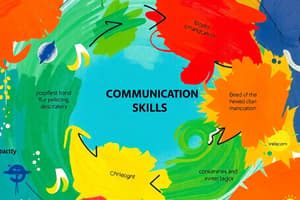Podcast
Questions and Answers
What is the role of the receiver in the communication cycle?
What is the role of the receiver in the communication cycle?
- Clarifies intentions of the message
- Interprets the message from the sender (correct)
- Provides feedback to the sender
- Initiates the message
Which component aims to convey information, clarify intentions, or express emotions?
Which component aims to convey information, clarify intentions, or express emotions?
- Sender
- Receiver
- Message (correct)
- Feedback
In the communication cycle, what serves to confirm or correct the message's reception?
In the communication cycle, what serves to confirm or correct the message's reception?
- Sender's interpretation
- Delayed feedback
- Receiver's perception
- Immediate feedback (correct)
Who transmits the message to the receiver in the communication cycle?
Who transmits the message to the receiver in the communication cycle?
What is the responsibility of the sender in communication?
What is the responsibility of the sender in communication?
In the scenario provided, what role does Jane play?
In the scenario provided, what role does Jane play?
Which step in the communication cycle involves the sender providing further explanations or guidance if necessary?
Which step in the communication cycle involves the sender providing further explanations or guidance if necessary?
What role does John (the support representative) play in the scenario?
What role does John (the support representative) play in the scenario?
Which digital platform is mentioned as an example to demonstrate the communication cycle in action?
Which digital platform is mentioned as an example to demonstrate the communication cycle in action?
What is essential in enhancing communication skills according to the text?
What is essential in enhancing communication skills according to the text?
Flashcards are hidden until you start studying
Study Notes
Understanding the Communication Cycle: Focus on Message, Feedback, Receiver, and Sender
The communication cycle, a fundamental concept in human interaction and information exchange, is a continuous process that sheds light on the intricate flow of messages, feedback, receivers, and senders. To explore this topic, let's dive into each component of the cycle and illustrate how they interact to facilitate successful communication.
Message
A message is the content that a sender transmits to a receiver. It can be conveyed in various forms, such as spoken words, written notes, or nonverbal cues. The message aims to convey information, clarify intentions, or express emotions.
Feedback
Feedback is the response that a receiver provides to the sender. It serves to confirm or correct the message's reception and provides additional context or ideas, thereby enhancing the communication process. Feedback can be immediate, such as verbal affirmations or body language, or delayed, such as in a performance review or customer feedback survey.
Receiver
The receiver is the individual who receives the message from the sender. They interpret the message based on their own understanding, cognitive abilities, and background knowledge. The receiver's perception may vary, so it is essential to be sensitive to potential misinterpretations and misunderstandings.
Sender
The sender is the individual who initiates the message to the receiver. They are responsible for ensuring their message is clear, concise, and accurate. The sender also needs to be aware of the receiver's perspective and adapt the message accordingly.
The Communication Cycle in Action
Consider the following scenario: Jane, a customer, asks a support representative, John, a question about a product.
1. Jane (Receiver) receives the message from John, the support representative (Sender). The message is a clear answer to her question.
2. Jane (Receiver) provides feedback by asking clarifying questions or expressing her understanding.
3. John (Sender) receives the feedback and provides further explanations or guidance if necessary.
4. Jane (Receiver) provides additional feedback to confirm her understanding or clarify any remaining doubts.
5. John (Sender) provides final feedback to ensure Jane has a thorough understanding of the information and that her needs are met.
This simple exchange illustrates the continuous flow of messages and feedback, with both the sender and receiver playing active roles in the communication process.
Modern Examples
The communication cycle is not limited to traditional face-to-face interactions. In the digital age, we can observe this process in action on platforms like Microsoft Bing Chat, which offers a No Search feature that allows users to control whether Bing Chat searches the web for answers or not. In the context of this feature, the message is the user's question, the sender is Bing Chat, and the feedback is the response, which may or may not include web search results.
Reflection
Understanding the communication cycle is essential in various settings, including interpersonal communication, team collaboration, and digital interactions. By identifying and acknowledging the roles of message, feedback, receiver, and sender, we can enhance our communication skills and ensure that our messages are conveyed effectively and accurately.
Studying That Suits You
Use AI to generate personalized quizzes and flashcards to suit your learning preferences.




